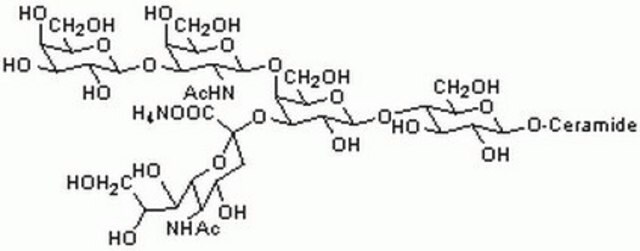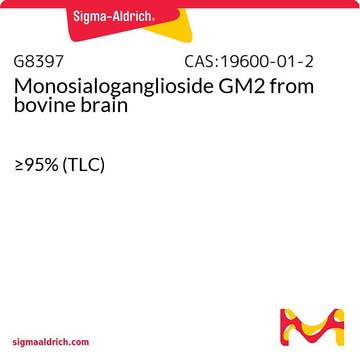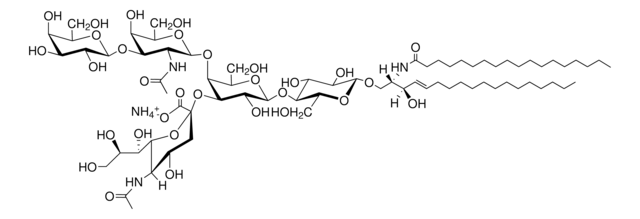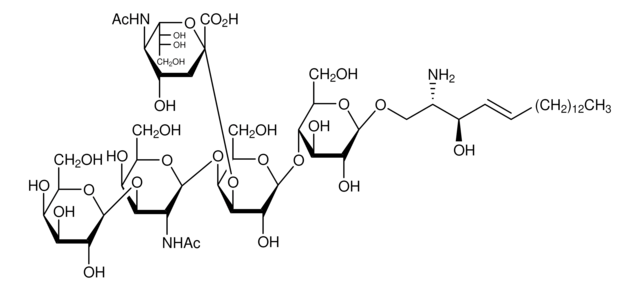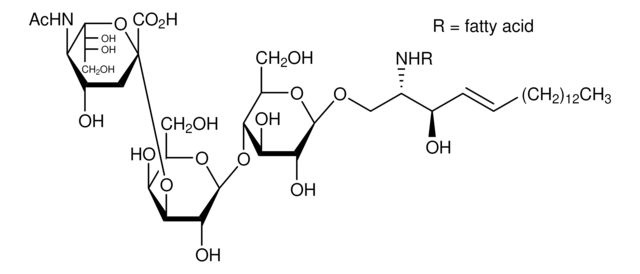Key Documents
G7641
Monosialoganglioside GM1 from bovine brain
≥95% (TLC), lyophilized powder, sialoglycolipid
Synonim(y):
Ganglioside GM1, monosialo
About This Item
Polecane produkty
product name
Monosialoganglioside GM1 from bovine brain, ≥95%, lyophilized powder
Poziom jakości
Próba
≥95%
Postać
lyophilized powder
temp. przechowywania
−20°C
ciąg SMILES
CCCCCCCCCCCCCCCCCCCC(=O)N[C@H](CO[C@@H]1O[C@H](CO)[C@@H](O[C@@H]2O[C@H](CO)[C@H](O[C@@H]3O[C@H](CO)[C@H](O)[C@H](O[C@@H]4O[C@H](CO)[C@H](O)[C@H](O)[C@H]4O)[C@H]3NC(C)=O)[C@H](O[C@@]5(C[C@H](O)[C@@H](NC(C)=O)[C@@H](O5)[C@H](O)[C@H](O)CO)C(O)=O)[C@H]2O)[C@H](O)[C@H]1O)[C@@H](O)\C=C\CCCCCCCCCCCCCCC
InChI
1S/C73H131N3O31/c1-5-7-9-11-13-15-17-19-20-22-24-26-28-30-32-34-52(86)76-44(45(83)33-31-29-27-25-23-21-18-16-14-12-10-8-6-2)40-99-69-61(93)59(91)63(50(38-79)102-69)104-71-62(94)67(98-41-47(85)55(87)66-53(74-42(3)81)46(84)35-73(97,107-66)72(95)96)64(51(39-80)103-71)105-68-54(75-43(4)82)65(57(89)49(37-78)100-68)106-70-60(92)58(90)56(88)48(36-77)101-70/h31,33,44-51,53-71,77-80,83-85,87-94,97H,5-30,32,34-41H2,1-4H3,(H,74,81)(H,75,82)(H,76,86)(H,95,96)/b33-31+/t44?,45?,46-,47?,48+,49+,50+,51+,53+,54+,55?,56-,57-,58-,59+,60+,61+,62+,63+,64-,65+,66+,67+,68-,69+,70-,71-,73-/m0/s1
Klucz InChI
CNLVNZJJSHZYAS-ALSOZVJRSA-N
Szukasz podobnych produktów? Odwiedź Przewodnik dotyczący porównywania produktów
Amino Acid Sequence
Opis ogólny
Zastosowanie
- in GM1 capture enzyme-linked immunosorbent assay (ELISA)
- for the quantification of cholera toxin B subunit (CTB)-p277 protein accumulation
- for Escherichia coli heat-labile enterotoxin (LT-B) detection
- to determine the affinity of the GM1-ganglioside receptor for the plant-derived Escherichia coli heat-labile toxin LTK63 protein
Działania biochem./fizjol.
Kod klasy składowania
11 - Combustible Solids
Klasa zagrożenia wodnego (WGK)
WGK 3
Temperatura zapłonu (°F)
Not applicable
Temperatura zapłonu (°C)
Not applicable
Środki ochrony indywidualnej
Eyeshields, Gloves, type N95 (US)
Certyfikaty analizy (CoA)
Poszukaj Certyfikaty analizy (CoA), wpisując numer partii/serii produktów. Numery serii i partii można znaleźć na etykiecie produktu po słowach „seria” lub „partia”.
Masz już ten produkt?
Dokumenty związane z niedawno zakupionymi produktami zostały zamieszczone w Bibliotece dokumentów.
Klienci oglądali również te produkty
Nasz zespół naukowców ma doświadczenie we wszystkich obszarach badań, w tym w naukach przyrodniczych, materiałoznawstwie, syntezie chemicznej, chromatografii, analityce i wielu innych dziedzinach.
Skontaktuj się z zespołem ds. pomocy technicznej
